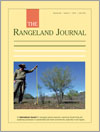RJ16047Barking up the wrong tree? Are livestock or rabbits the greater threat to rangeland biodiversity in southern Australia?
Increasingly widespread provision of stock water is seen as a threat to Australian rangeland vegetation, but attempts to demonstrate that vegetation composition is better at sites more distant from water have been largely unsuccessful. One likely reason is that most studies have been conducted within the geographic range of rabbits but without accounting for rabbits’ impact. Successful strategies to define the problem and to conserve vegetation in southern Australian rangelands will need to address the impact of rabbits and large water-dependent herbivores simultaneously.




